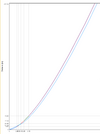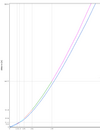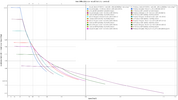Welcome to Tesla Motors Club
Discuss Tesla's Model S, Model 3, Model X, Model Y, Cybertruck, Roadster and More.
Register
Install the app
How to install the app on iOS
You can install our site as a web app on your iOS device by utilizing the Add to Home Screen feature in Safari. Please see this thread for more details on this.
Note: This feature may not be available in some browsers.
-
Want to remove ads? Register an account and login to see fewer ads, and become a Supporting Member to remove almost all ads.
You are using an out of date browser. It may not display this or other websites correctly.
You should upgrade or use an alternative browser.
You should upgrade or use an alternative browser.
Why Tesla doesn't use an "overdrive" for better range?
- Thread starter MikeRTX
- Start date
gearchruncher
Well-Known Member
Power is force * velocity. Joules are energy. Power is kW. Energy is kWh. They are not in conflict. A motor creates power (kW). A fuel tank stores energy (kWh).With this I don't agree. I would give you the detailed explanation but I was warned by the admin to stop posting links here, so I will not. The explanation is not short... It took me several years to understand it (rallying years + simulations on computer). Recently I found that in 1770 James Watt thought of power as Force * Velocity and also that back then power could mean "ability to act". Only in 1840 joule introduced the energy concept.
A Watt is a Joule per second. We use both names, it's not like this is proof that one is right or wrong. What is your point that one was understood in 1770 and the other in 1840?
But since you can hide behind the "I can't post links" we'll never get anywhere since you aren't making any sort of coherent argument about why you can't understand power unless you understand both torque and RPM. This is very much starting to sound like a conspiracy theory where you tell others to "do their research" and that you've found a way to make cars faster if you just put transmissions in them.
Just know that you are violating basic physics with an argument that power doesn't create acceleration, torque and RPM do. Because of course famously, the only way to have power is via rotation, and kinetic energy doesn't exist as a function of inputting power for a specific amount of time
This is nonsensical. All things in the universe transform into heat. Everything else is temporary,PS. Battery Power transforms into force +heat. The calculated power from measured force (torque) is only the energy rate at which the not wasted energy is transformed into force.
Some EV manufacturers use two different gear ratios on two different drive motors for performance or economy reasons.
EVs tend to use one fixed ratio on single motors due to costs, complexity, reliability and weight.
Engineering term is that the juice is not worth the squeeze :+)
EVs tend to use one fixed ratio on single motors due to costs, complexity, reliability and weight.
Engineering term is that the juice is not worth the squeeze :+)
M
mariusciclistu
Guest
Attached the explanation.Power is force * velocity. Joules are energy. Power is kW. Energy is kWh. They are not in conflict. A motor creates power (kW). A fuel tank stores energy (kWh).
A Watt is a Joule per second. We use both names, it's not like this is proof that one is right or wrong. What is your point that one was understood in 1770 and the other in 1840?
But since you can hide behind the "I can't post links" we'll never get anywhere since you aren't making any sort of coherent argument about why you can't understand power unless you understand both torque and RPM. This is very much starting to sound like a conspiracy theory where you tell others to "do their research" and that you've found a way to make cars faster if you just put transmissions in them.
Just know that you are violating basic physics with an argument that power doesn't create acceleration, torque and RPM do. Because of course famously, the only way to have power is via rotation, and kinetic energy doesn't exist as a function of inputting power for a specific amount of time
This is nonsensical. All things in the universe transform into heat. Everything else is temporary,
Attachments
Last edited by a moderator:
"The shifting rotational speeds in each gear depends ONLY by the gear ratios in the transmission and theAttached the explanation.
For the moderator: pls do not approve my previous reply with this pdf as link.
engine’s torque graph."
You're hiding engine horsepower in this statement.
Ideally, your shift points corresponding to the same engine power output on opposite sides of the power curve.
R: gear ratio
a/b: shift points
HP=RPM*TQ/5252
HPa=HPb
RPMa=speed/Ra
RPMb=speed/Rb
speed/Ra*TQa/5252=speed/Rb*TQb/5252
TQa/Ra = TQb/Rb
M
mariusciclistu
Guest
I agree. But it is worth mentioning that with the same torque curve, if multiple gears would be present, the acceleration would be improoved both at low and high rpms but the added weight might spoil that.Some EV manufacturers use two different gear ratios on two different drive motors for performance or economy reasons.
EVs tend to use one fixed ratio on single motors due to costs, complexity, reliability and weight.
Engineering term is that the juice is not worth the squeeze :+)
As a reference the attached picture shows a tesla with 6 gears; time on x and distance on y axis (same weight 2112 kg). The gears being 9.82 gear ratio for the production one and for the simulation, same final gear ratio but with 2, 1.8, 1.6, 1.4, 1.2, 1 (from 1th to 6th). The simulation would be faster: 11,24 vs 11.54s on 402.34m and 18.08 vs 18.43s on 773.94m.
Second and third pictures: 2, 1.7, 1.4, 1.1, 0.8, 0.5 (from 1th to 6th) 10.94s vs 11.54s on 402.34m.
Attachments
Last edited by a moderator:
gearchruncher
Well-Known Member
The Plaid runs 7.56:1 gears, and does 402m in 9.5 seconds. Not sure what your graphs have to do with a flat POWER curve, given a real plaid already crushes your simulation.
Yes, we all agree that if there is a non-flat power curve and power decreases with RPM, then a gear can help. We've known that for 150 years with internal combustion engines. Your paper seems to act like that's new knowledge? Why do you think cars have transmissions? And yes, you can optimize gear ratios for different needs.
Plaid solves this by having a flat POWER curve from 60 MPH to 200 MPH with a 7.56:1 gear ratio between the motors and wheels. Below 60 MPH, it's torque limited which leads to a power limit, but this is irrelevant because it's already beyond the tire capability, and tires have torque limits too, so you can't just gear your motor to high wheel torque and assume it works. Sure, if they wanted to they could theoretically gear down the Plaid even more and maybe decrease the 0-150 time at the expense of top speed.
Your paper opens with a discussion of how changing wheel size changes the acceleration of a car. That's obvious to the most casual observer, but it seems like a revelation to you and your paper, but it doesn't give the reader faith that you're an expert in this area.
Yes, we all agree that if there is a non-flat power curve and power decreases with RPM, then a gear can help. We've known that for 150 years with internal combustion engines. Your paper seems to act like that's new knowledge? Why do you think cars have transmissions? And yes, you can optimize gear ratios for different needs.
Plaid solves this by having a flat POWER curve from 60 MPH to 200 MPH with a 7.56:1 gear ratio between the motors and wheels. Below 60 MPH, it's torque limited which leads to a power limit, but this is irrelevant because it's already beyond the tire capability, and tires have torque limits too, so you can't just gear your motor to high wheel torque and assume it works. Sure, if they wanted to they could theoretically gear down the Plaid even more and maybe decrease the 0-150 time at the expense of top speed.
Your paper opens with a discussion of how changing wheel size changes the acceleration of a car. That's obvious to the most casual observer, but it seems like a revelation to you and your paper, but it doesn't give the reader faith that you're an expert in this area.
M
mariusciclistu
Guest
I have only that Tesla SP as input values so it was just an example of the amount of seconds that could be gained by theoretical gearing while keeping the same weight, that enforce what others said previously here that it does not worth it. If I missed exact values given as answers previously, please escuse me. I am an engineer and I like to say a value rather than just: more, less, big small, better, worse. I was curious why tesla choose to use only one gear, that is how I ended up here.The Plaid runs 7.56:1 gears, and does 402m in 9.5 seconds. Not sure what your graphs have to do with a flat POWER curve, given a real plaid already crushes your simulation.
Please explain the flat power curve. Is it meant to keep the battery drainage in certain limits? If yes then I understand why you keep mentioning it. But that is a limitation from the energy source not a limitation from the tires etc. When discussing about acceleration and gears, torque graph is the starting point for any simulation.Yes, we all agree that if there is a non-flat power curve and power decreases with RPM, then a gear can help. We've known that for 150 years with internal combustion engines. Your paper seems to act like that's new knowledge? Why do you think cars have transmissions? And yes, you can optimize gear ratios for different needs.
Plaid solves this by having a flat POWER curve from 60 MPH to 200 MPH with a 7.56:1 gear ratio between the motors and wheels. Below 60 MPH, it's torque limited which leads to a power limit, but this is irrelevant because it's already beyond the tire capability, and tires have torque limits too, so you can't just gear your motor to high wheel torque and assume it works. Sure, if they wanted to they could theoretically gear down the Plaid even more and maybe decrease the 0-150 time at the expense of top speed.
Sorry if this highjacks this thread's question. It was not my intention. Noone is expert until recognized by others but that does not mean that an expert is always right.Your paper opens with a discussion of how changing wheel size changes the acceleration of a car. That's obvious to the most casual observer, but it seems like a revelation to you and your paper, but it doesn't give the reader faith that you're an expert in this area.
GlmnAlyAirCar
Active Member
Are you sure? I’ve been working out….You cannot turn an ICE by hand to 5,000 rpm
Similar threads
- Replies
- 3
- Views
- 363
- Replies
- 75
- Views
- 4K
- Replies
- 0
- Views
- 253
- Replies
- 85
- Views
- 4K





